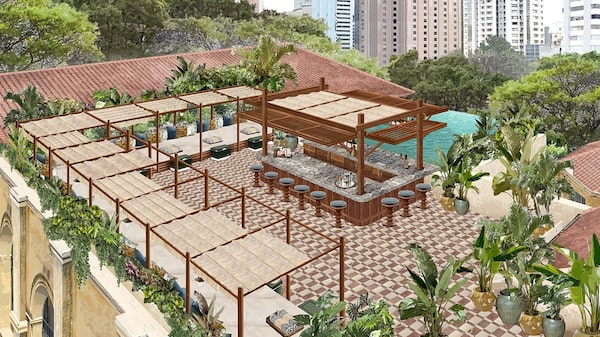Bloomberg Línea — São Paulo is the 12th city in the world with the most buildings with sustainability certification, according to a global study by real estate consultancy JLL and obtained exclusively by Bloomberg Línea. But more than simply “green”, now new building projects seek another type of seal, that of user well-being.
According to the US-based consultancy, 71% of high-end developments in São Paulo are certified with a so-called ‘green’ seal, and are buildings designed to have a reduced impact on the environment at all stages of their life cycle.
Of the 40 cities in the world analyzed in the study, São Paulo appears ahead of cities that have long invested in sustainability, according to JLL, such as Miami (66% of the total high standard), Los Angeles (65%), New York (61%), Tokyo (51%), Seoul (45%) and Beijing (40%).
In the case of ‘green’ labels, the best known in Brazil is LEED, and approximately 1,500 buildings already have this certification in the country.
According to JLL’s sustainability director, Luciana Arouca, the ‘green’ seal attests that a building meets several criteria, such as responsible energy and water consumption, maximum use of natural light, as well as waste management processes.
JLL’s Arouca explained that the age of the development determines the complexity of the process of obtaining certification. “The investment to adapt an old building will be much higher. The big trend is for new developments to come out with a green seal or at least prepare the project to obtain it later,” she said in an interview with Bloomberg Línea.
She added that large tenants, mainly global companies, check the sustainability criteria of the developments before signing the lease, often with the requirement of so-called “green clauses”.
“It’s a way of agreeing with the landlord that, within a certain period, the development commits to achieving certain efficiency targets,” she said.
According to JLL, a third of company CEOs plan to move out of less carbon-efficient spaces by 2025.
The consultancy’s survey also showed that green-certified developments have lower vacancy rates, even in neighborhoods or regions where these rates are higher.
There are other benefits, too. In the prime area of São Paulo, for example - which covers Faria Lima, Berrini/Chucri Zaidan, Itaim, JK, Paulista and Vila Olímpia - the asking price for the leasing of buildings with a green seal is, on average, 20% higher than in non-certified buildings.
Arouca says the stock of green certifications in Brazil is dominated by high-end buildings, but this is gradually changing, amid “pressure from stakeholders and clients for these issues to be taken into account when signing a company lease”.
She added that companies are questioning less and less whether corporate developments should have green certification or not.
Buildings for well-being
There are also other trends in office occupancy and high-end buildings. “We see companies chasing not only a green seal but also a well-being seal,” Arouca said. Among the criteria analyzed to grant this seal are, among others:
- air quality
- incidence of sunlight
- ‘decompression’ areas, and leisure areas or rooms
- a space for breastfeeding
- provision of healthy food
- accessible transportation for all users
The most widely adopted well-being certification in Brazil is called WELL, which encompasses about 100 criteria.
“We have noticed an increase in interest in this certification and also in the so-called social clauses, which, like the green ones, require future adjustments in the enterprise,” Arouca said.
Currently, only eight projects have the WELL seal in Brazil, such as Birmann 29, on Avenida Brigadeiro Faria Lima. Covering 9,674 square meters, the building is 25 years old and, among its occupants, is JP Morgan. In Rio de Janeiro, the US bank also occupies the only WELL-certified building in the city, the Argentina Building in Botafogo.

The headquarters of BR Properties (BRPR3) is located in a development of the group in Parque da Cidade, on Avenida das Nações Unidas, in São Paulo, which also has the seal. According to WELL, after the diagnosis and implementation of adjustments in the building, there was a “better quality of water and air inside the office”, a positive impact of the use of circadian lighting - which favors productivity during the day and relaxation at night - in addition to criteria related to food, mind and body.
Despite the low number of buildings with this certification in Brazil, around 120 enterprises are waiting for an audit to obtain the WELL seal in the country.
Moving toward stability
In a still challenging scenario, with high capital and construction costs, investors in the real estate sector remain cautious. But this scenario is starting to improve, according to the managing director and head of Paladin Realty in Brazil, Ricardo Raoul,who says the real estate market is moving toward stability.
“After the pandemic, land prices rose a lot and construction costs skyrocketed. But we should have a more stable scenario in the coming months. We are moving toward a balance,” he said.
Arouca said she believes there is no reason to start a real estate development without seeking green and wellness certifications. “This is not only a trend in mature markets, it is a reality here too,” she said.



